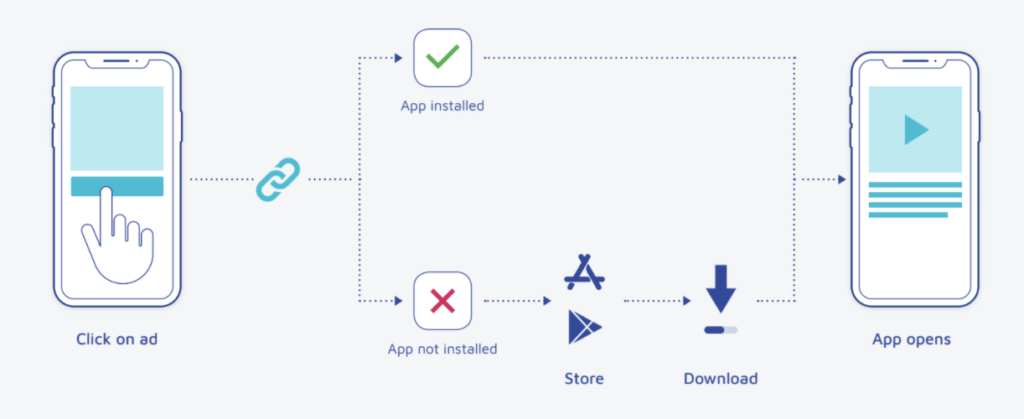
Author: Anna Priester
– Former App Marketing Content Specialist at Customlytics
We want to introduce you to our new deep linking eBook that surges as a learning resource for all marketing managers and product managers to get a better understanding of the concept of deep linking.
We see deep links as a necessity for mobile marketers to meet today’s standards of how to deliver a seamless user experience and master mobile marketing. The ability to generate deep links must be an essential part of their toolkit.
How do we come up with this? App deep links make the difference for successful mobile marketing campaigns: They can direct a user from the web to an app or a particular location within an app rather than just launching the app’s home page. Users get exposed to their desired content directly without the hassle of having to switch across platforms.
Therefore, deep linking provides mobile marketers with more options to get users into their apps by delivering an increasingly targeted and personalized user experience. Today there is an array of proven use cases of deep linking.
But before taking a closer look at the use cases, let’s get started with the concept of deep linking and its structure.
The concept of deep linking
App deep links can be compared to URLs for websites. But there is one crucial difference: These URLs don’t contain the ability to link anywhere other than sites within web browsers. Deep links whereas can direct a user to a specific location with the desired content directly within an app.
Smartphone users have become accustomed to this technology. Finding the right product or page without deep links is exhausting and the probability to lose customers at an early stage of the customer journey is higher. If mobile markets don’t make use of this tool in the mobile growth stack of an app, they simply won’t be able to reach all users and realize the full potential of mobile marketing campaigns. It takes an improved UX to drive users throughout the conversion funnel and prevent them from quitting halfway through due to the time taken today.
The key advantages of deep links for mobile marketers are:
- Offering a better overall user experience with less friction and reduced user frustration ensures happier, stickier users. Happy users promise to keep retention rates high.
- If retention rates still drop, deep linking provides mobile marketers with great possibilities to retarget and activate lapsed users. By including deep links in retargeting campaigns, mobile marketers can redirect the user right back into the desired view of their app upon clicking on the retargeting ad – ideally to a reward straight away.
- Another way that mobile marketers can counteract low retention rates and increase conversions is by using all the data they are constantly gathering. With all relevant information and custom data, mobile marketers are empowered to build strong personalization features and customize user experiences.
To sum up the key advantages of deep linking for your mobile marketing: Deep links help you optimize your app marketing campaigns, increase conversions, improve engagement by personalization, and build retention.
This makes it all the more remarkable that most apps do not support deep linking. Yet, integrating deep links is simple and doesn’t require an additional tool. Once mobile marketers understand the deep linking structure, they can get started with creating links, handing them over to their developers, who implement them in the app – and that’s about it for standalone deep links. See in our eBook, which basic structural elements deep links must contain.
Looking at the structure and creating deep links, it is important to know for mobile marketers that their app will need to be updated in order to change the deep link structure.
Types of mobile deep linking
Today, there are two types of deep linking technology in use.
1. Standard deep links
Standard deep links direct a user to specific app content using the app URL. The issue with traditional deep linking is that the user will not be able to open the content if the app isn’t installed already.

2. Deferred deep linking
Deferred deep linking comes into play when users haven’t installed the app yet. Using deferred deep links, the user will be directed to the App Store or Play Store first to download the app. Deep linking then makes sure that the user gets to the “deferred” content/location in the app immediately after downloading and launching the app.

Source: AppsFlyer
Google and Apple require their own deep linking setups for their operating systems Android (Android App Links) and iOS (Universal Links). In our eBook, we explain to you how to approach each.
The one major difference when looking at the approaches that Apple and Google have taken towards universal deep links is that Apple is essentially enforcing them (practically starting to deprecate traditional custom URL scheme based deep linking as shown before in this article) while Google is only recommending to use them, maintaining full functionality of the traditional deep linking for Android at this point.
Use cases of deep linking
As spoilered in the beginning, there are many proven use cases of deep linking. We provide you with the most common ones more detailed in our eBook:
- From website to app
- From social media to app
- From email to app
- From search result to app
- Via push message
- Via in-app message
- Via QR Code
As more platforms and channels have evolved, cross-promotions have become increasingly important to master mobile marketing. Cross-promotions thrive thanks to deep linking as mobile marketers can provide users/ potential customers with a seamless UX across platforms.
If you want to get started with deep linking to optimize your app marketing campaigns, increase conversions, improve engagement and build retention, reach out to us via [email protected]. Our mobile experts have many years of experience in deep linking and can help you to generate deep links for your app.
💡 Knowledge sharing is at the core of what we do. Learn more about the app industry and discover useful resources by signing up for our newsletter or by bookmarking the Customlytics App Marketing blog in English or German.
📚 We love useful stuff. That’s why we co-wrote the Mobile Developer’s Guide to the Galaxy. Get your free paperback copy or download the eBook here providing you with all the mobile knowledge you need.
💜 Become part of our community on LinkedIn, Twitter, Xing, Glassdoor or Medium.




